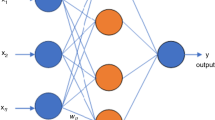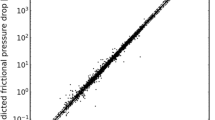Abstract
The purpose of this paper is to focus on the experimentally obtained results of impinging jet applications by the help of two different analysis methods. Circular round pipes (D = 7.9, 10.8, 13.8 and 23.1 mm) have been used as the impinging jets. The heat transfer is calculated with Nusselt number (Nu). The variable parameters are the dimensionless jet-to-impingement plate distance (z/D), Reynolds number (Re) and dimensionless temperature measurement points on the heated surface (x/L, y/L). Some important analysis methods such as artificial neural network (ANN), statistical regression, and uncertainty analysis are applied to the obtained data. It is shown that the ANN application is not simply a classification analysis; it is actually an application of the convergence of functions. As a result, by considering random data, 4.57% convergence level is obtained regarding the pipe diameter. The software STATISTICA 5.0 is used to estimate new empirical correlations nonlinearly. The smallest regression coefficient for the correlations is 0.87, while the highest value is 0.99. The result of the uncertainty analyses showed that the total uncertainties are in the agreeable range; 8% for Nu, and 2.89% for Re.






Similar content being viewed by others
Abbreviations
- A :
-
heat transfer area (m2)
- b h j (k):
-
biases of the hidden layer
- b h1 (n):
-
biases of the output layer
- C l :
-
specific heat (J/kg °C)
- D :
-
inner diameter of each pipe (m)
- g :
-
gravitational acceleration (m/s2)
- h fg :
-
latent heat of vaporization (J/kg)
- h :
-
local heat transfer coefficient (W/m2 C°)
- \( \bar{h} \) :
-
average heat transfer coefficient (W/m2 C°)
- Ja :
-
Jacob number
- k :
-
thermal conductivity (W/m C°)
- (k):
-
training pattern index
- L :
-
height of the vertical plate (m)
- N :
-
number of inputs, outputs, biases
- Nu :
-
Nusselt number
- \( \overline{Nu} \) :
-
average Nusselt number
- N U (k):
-
output of the neural network
- Q :
-
rate of heat (W)
- R 2 :
-
regression coefficient
- Re :
-
Reynolds number (−)
- T :
-
temperature (°C)
- U i (k):
-
features
- W :
-
uncertainty of each parameter (%)
- W i o j (k):
-
weights from the input to the hidden layer
- W o j (k):
-
weights from the hidden to the output layer
- x, y :
-
coordinates on surface (m)
- X j (k):
-
outputs of the hidden layer neurons
- z :
-
jet to plate distance (m)
- μ :
-
dynamic viscosity (kg/ms)
- ν :
-
kinematic viscosity of air (m2/s)
- ρl :
-
density (kg/m3)
- \( \dot{V} \) :
-
volumetric flow rate of air (m3/s)
- cond :
-
condensation
- impinged :
-
after impingement
- j :
-
jet
- l :
-
liquid
- local :
-
local
- losses :
-
losses (heat)
- surf :
-
surface
- sat :
-
saturation state
- w :
-
wall
- v :
-
vapor
- 0 :
-
stagnation point
- m, n :
-
correlation exponents
- C, k, p, q :
-
correlation coefficients
References
Aamir MA, Awais MM, Watkins AP (2002) Application of artificial neural networks modeling to sprays and spray impingement heat transfer. Atomization Sprays 12:359–386
Asan H, Namli L (1997) Uncertainty analysis on the applications of heat transfer and pressure losses. ULIBTK’97, 11th National heat science and heat technique congress, Edirne, Turkey, pp 369–378
Ashforth-Frost S, Fontama VN, Jambunathan K, Hartle SL (1995) Role of neural networks in fluid mechanics and heat transfer. IEEE instrumentation and measurement techniques conference, pp 6–9
Ayhan-Sarac B, Karlık B, Bali T, Ayhan T (2007) Neural network methodology for heat transfer enhancement data. Int J Numer Methods Heat Fluid Flow 17(8):788–798
Ayhan T, Karlik B, Tandiroglu A (2004) Flow geometry optimization of channels with baffles using neural networks and second law of thermodynamics. Comput Mech 33(2):139–143
Basu A, Chellamani KP, Kumar PR (2002) Application of neural network to predict the properties of air-jet spun yarns. J Instit Eng (India). Part TX: Textile Engineering Division 83:1–4
Berk RA (2004) Regression analysis; a constructive critique. Sage Publications, USA
Bethea RM, Duran BS, Boullion TL (1985) Statistical methods for engineers and scientists. ISBN 0-8247-7227-X. Marcel Dekker, New York
Celik N (2006) Investigation of the effects of optimum nozzle type on the impinging jets. Ph.D. thesis, University of Firat Elazig, Turkey
Cook RD, Weisberg S (1982) Criticism and influence analysis in regression. Sociol Method 13:313–361
Freedman DA (2005) Statistical models; theory and practice. Cambridge University Press, USA
Gulbag A, Temurtas F (2006) A study on quantitative classification of binary gas mixture using neural networks and adaptive neuro fuzzy inference systems. Sens Actuators B 115:252–262
Hoogendorn CJ (1977) The effect of turbulence on heat transfer at a stagnation point. Int J Heat Mass Transf 20:1333–1338
Incropera FP, De Witt DP (1981) Fundamentals of heat and mass transfer, 2nd edn. Wiley, New York
Islamoglu Y, Kurt A, Parmaksizoglu C (2005) Performance prediction for non-adiabatic capillary tube suction line heat exchanger: an artificial neural network approach. Energy Conver Manage 46(2):223–232
Kalogirou SA (2000) Applications of artificial neural-networks for energy systems. Appl Energy 67(1–2):17–35
Kazuyuki Y, Masami I, Naoyuki H, Koichi H (2006) Neural network control of temperature profile by impinging jet arrays. JSME Int J Ser B 49(4):951–958
Kline SJ, McClintock FA (1953) Describing uncertainties in single-sample experiments. Mech Eng 75:3–8
Liu HT, Sun SK, Liu ZP, Wang XS (2005) Atomization prediction based on artificial neural networks for flood releasing of high dams. Shuili Xuebao/J Hydraul Eng 36(10):1241–1245
Martin H (1977) Heat and mass transfer between impinging gas jets and solid surfaces. Adv Heat Transf 13:1–60
Matlab® Documentation (2004) Version 7.0, Release 14, The MathWorks, Inc., USA
McIntosh JEA, McIntosh RP (1980) Mathematical modeling and computers in endocrinology, vol 71. Springer, Berlin
Mohanty AK, Tawfek AA (1993) Heat transfer to a round jet impinging normal to a flat surface. Int J Heat Mass Transf 36(6):1639–1647
Motulsky HJ, Ransnas LA (1987) Fitting curves to data using nonlinear regression. FASEB J 1:365–374
Ozbay Y, Karlik B (2002) A fast training back-propagation algorithm on windows. In: Proceedings of the 3rd international symposium on mathematical & computational applications, pp 204–210
Pacheco-Vega A, Sen M, Yang KT, McClain RL (1999) Prediction of humid air heat exchanger performance using artificial neural networks. ASME Heat Transf Div 364(3):307–314
Seber GAF, Wild CJ (1989) Nonlinear regression. Wiley, New York
Temurtas F, Gunturkun R, Yumusak N, Temurtas H (2004) Harmonic detection using feed forward and recurrent neural networks for active filters. Elec Power Syst Res 72:33–40
Thibault J, Grandjean BPA (1991) Neural network methodology for heat transfer data analysis. Int J Heat Mass Transf 34(8):2063–2070
Wang QW, Xie GN, Zeng M, Luo LQ (2006) Prediction of heat transfer rates for shell-and-tube heat exchangers by artificial neural networks approach. J Therm Sci 15(3):257–262
Xie GN, Wang QW, Zeng M, Luo LQ (2007) Heat transfer analysis for shell-and-tube heat exchangers with experimental data by artificial neural networks approach. Appl Therm Eng 27(5–6):1096–1104
Yigit KS, Ertunc HM (2006) Prediction of the air temperature and humidity at the outlet of a cooling coil using neural networks. Int Comm Heat Mass Transf 33(7):898–907
Author information
Authors and Affiliations
Corresponding author
Additional information
Dr. Nevin Celik is a Post Doctoral Fellowship in University of Minnesota since August 2007.
Rights and permissions
About this article
Cite this article
Celik, N., Kurtbas, I., Yumusak, N. et al. Statistical regression and artificial neural network analyses of impinging jet experiments. Heat Mass Transfer 45, 599–611 (2009). https://doi.org/10.1007/s00231-008-0454-9
Received:
Accepted:
Published:
Issue Date:
DOI: https://doi.org/10.1007/s00231-008-0454-9




